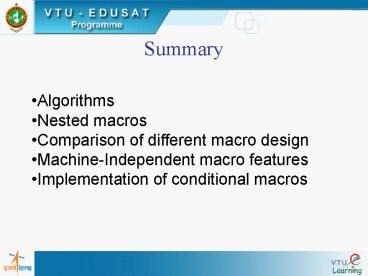S Seema - PowerPoint PPT Presentation
1 / 13
Title:
S Seema
Description:
Macro processor that do not depend on any particular language, can be used with ... can support macro instructions that depend upon the contect in which they occur. ... – PowerPoint PPT presentation
Number of Views:24
Avg rating:3.0/5.0
Title: S Seema
1
Summary
- Algorithms
- Nested macros
- Comparison of different macro design
- Machine-Independent macro features
- Implementation of conditional macros
2
General Purpose Macro Processors
- Macro processor that do not depend on any
particular language, can be used with variety of
languages. - Pros
- Programmers do not need not learn any macro
language. - Although its development costs is little high
than those for the language specific macro
processor, but these macros does not need to be
repeated for every language.
3
General Purpose Macro Processors
- Macro processor that do not depend on any
particular language, can be used with variety of
languages. - Cons
- Large number of details must be dealt within a
programming language. - Situations in which normal macro parameter
substitution should not occur, e.g., comments. - Facilities for grouping together terms,
expressions, or statements - Tokens, e.g., identifiers, constants, operators,
keywords. - Syntax must be consistent with the programming
language.
4
Macro Processing within language Translators
- Macro processor discussed so far are
preprocessors that - Process macro definitions
- Expand macro invocation
- Produces an expanded version of the macro at the
place of the call and then use it by the
assembler or the compiler. - Macro processing functions can be combined with
the language translators. - Line-by-line macro processors
- Integrated macro processors
5
Line-by-Line Macro Processors
- Used as sort of input routine the assembler or
compiler. - Read source program.
- Handle macro definition and expand the
invocation. - Pass output lines to the assembler or compiler.
- Benefits
- Avoid making an extra pass over the source
program. - Data structures required by the translators and
the macro processor can be kept same. - Utility subroutines by the translators and the
macros can be kept same. - Scanning input lines, Searching tables.
6
Integrated Macro Processors
- An integrated macro processor can make use of any
information about the source program that is
extracted by the language translators - An integrated macro processor can support macro
instructions that depend upon the contect in
which they occur.
7
Integrated Macro Processors
- Definitions and invocations of macros are
- handled by a preprocessor, which is generally not
integrated with the rest of the compiler. - Example
- DEFINE NULL 0
- DEFINE EOF (-1)
- DEFINE EQ
- DEFINE ABSDIF (x, y) XgtY?
X-YY-X
8
Integrated Macro Processors
- Parameter substitutions are not performed within
quoted. - define DISPLAY( EXPR) printf( EXPR d\ n,
EXPR) - Example
- DISPLAY( I J 1) gt printf( EXPR d\ n, I
J 1)
9
Integrated Macro Processors
- Parameter substitutions are not performed within
quoted. - define DISPLAY( EXPR) printf( EXPR d\ n,
EXPR) - Example
- DISPLAY( I J 1) gt printf( EXPR d\ n, I
J 1)
10
Integrated Macro Processors
- Recursive macro definitions or invocations
- After a macro is expanded, the macro processor
rescans the text that has been generated, looking
for more macro definitions or invocations. - Macro cannot invoke or define itself
recursively. - Example
- DISPLAY( ABSDIFF( 3, 8))
- SCANS
- printf( ABSDIFF( 3, 8) d\ n, ABSDIFF( 3,
8)) - RESCANS
- printf( ABSDIFF( 3, 8) d\ n, ( (3)gt( 8) ?
(3) - - (8) (8)-( 3) ))
11
ANSI C Macro Language
- Conditional compilation statements
- Example 1
- ifndef BUFFER_ SIZE
- define BUFFER_ SIZE 1024
- endif
- Example 2
- define DEBUG 1
- if DEBUG 1
- printf() / debugging outout /
- endif
12
MACRO Macro Processor
- ABSDIF J,K
- MOV AX,J
- SUB AX, K
- JNS ??0000
- NEG AX
- ??0000
13
MACRO Macro Processor
- ABSDIF MACRO OP1, OP2, SIZE
- LOCAL EXIT
- IFNB ltSIZEgt
- IFDIF ltSIZEgt ltEgt
- ERR
- EXITM
- ENDIF
- ENDIF
- MOV SIZEEAX, OP1
- SUB SIZEAX, OP2
- JNS EXIT
- NEG SIZEAX
- EXIT
- ENDM

